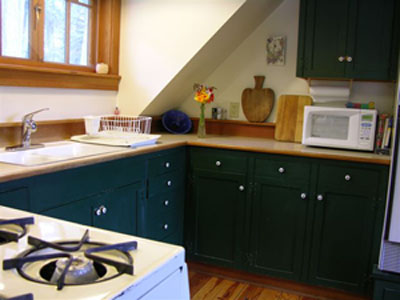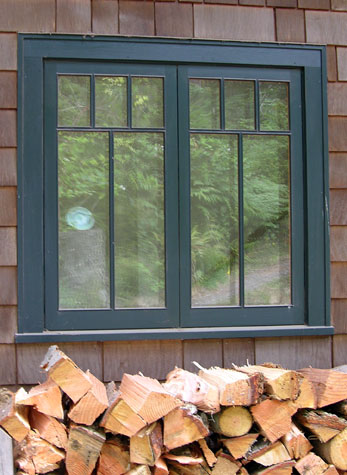Garden House on Orcas Island
Construction History
The Garden House was designed during
the winter and early spring of 1987. The building was to meet
several purposes and functions: a study or
'mental-work-place', a shop, and a guest space. There were
several design iterations (Joe redrew the plans 3 or 4 times)
until the design was settled. Under San Juan County's
building department regulations, if you build a home for
yourself you do not need to hire a contractor-rather, you can
qualify for an 'owner-contractor' building permit, which was
obtained. The septic tank and drainfield were installed in
what is now the garden and the foundation was poured in May.
Starting in early June, Joe and Tim Simonian, Orcas's best
carpenter, began transforming marks on paper into wood,
nails, and sweat. Beginning at 7 am and working till 9 pm,
the building was framed, sided, and roofed by these two
intrepid (and lifelong) friends. Tim started with only a 3
week window in June, but fortunately this window stretched
into September, when he went on to the project he had been on
hold for. Joe did the wiring and plumbing, subcontracted the
sheet rock hanging and taping to Chuck Silva and Dennis
Cullen, asked Fred Enge to help with the paint colors and
painting; the floor sanding and finishing was subbed to Rick
Waldron on Friday Harbor. Tim came back (his project became
delayed) with Brian Ashley to put up the clear vertical grain
douglas fir trim around the windows and doors and lay the fir
stairs. The windows and exterior doors were designed to match
the main house and built by San Juan Wood Design on Friday
Harbor.
Gary Sisson,  Orcas's best cabinetmaker,
built the kitchen and bathroom cabinets around a
collaborative design. Accuride drawer
slides were chosen because they move soooo smoothly, carry an
outrageous design load, and are full extension. The light
fixtures (except the lights above the kitchen counters) came
from Captain Sams in Seattle, and were recycled from an old
Seattle hotel. A planned but never installed light fixture
for the kitchen just left of the stove presumed the table
might be located there.
Orcas's best cabinetmaker,
built the kitchen and bathroom cabinets around a
collaborative design. Accuride drawer
slides were chosen because they move soooo smoothly, carry an
outrageous design load, and are full extension. The light
fixtures (except the lights above the kitchen counters) came
from Captain Sams in Seattle, and were recycled from an old
Seattle hotel. A planned but never installed light fixture
for the kitchen just left of the stove presumed the table
might be located there.
 We've got a large butcher block which
could serve as an island there but it would take 8 men and a
crane to get it upstairs so that project is on the back
burner; hence, the extra (unused) light switch at the
entrance to the kitchen. Most of the interior six-panel fir
doors came from Frank's Lumber in Seattle; they are seconds
(and thus half price) but we can't figure out what's wrong
with them.
We've got a large butcher block which
could serve as an island there but it would take 8 men and a
crane to get it upstairs so that project is on the back
burner; hence, the extra (unused) light switch at the
entrance to the kitchen. Most of the interior six-panel fir
doors came from Frank's Lumber in Seattle; they are seconds
(and thus half price) but we can't figure out what's wrong
with them.
The building design is rather classic northwest; it
follows a
pattern similar to Tim's 'shop' (now his home) and Marcy
Lund's home (built, yes you guessed it, by Tim and Chuck
Silva). It's a story and a half design; the second floor (700
square feet total)
feels big because of the cathedral ceilings and particularly
the large, shed roof dormers, though the height of the
'walls' (except where the dormers are) is only 3 feet. The
tiny bathroom 'works' because of the skylight, giving enough
head space for the sink, allowing the toilet to be over in
the standing room section of the floor. The building design
has, to some, the drawback that the dormer windows are high off
the floor-if you look out these windows, you'll see the roof comes
right up to the base of the window, an unavoidable result of
the dormer concept and the 3 foot 2nd story wall height. (What
this means is that you can only look out the dormer windows
when standing.)
The tradeoff was to make a full second story for the building,
which would have allowed the windows to be lower but would
have made the building seem really tall--too big and out of
scale to the landscape. Of course, what's hiding in this
discussion is the fact that the second floor is a full eleven
feet off the first floor, not the usual wimpy 8 feet, in
order for the shop section of the building to work well. Who
wants to pick up a 4x8 sheet of plywood and simultaneously
trash the ceiling, the ceiling lights, and your lower back?
The beams for the second floor came from local island
trees
(one from this property, cleared for the garden) and were
milled by Joe Bond, just up the road past the Doe Bay Resort.
They are 20 feet long 4x12's on 32" centers, which just meets
the code requirements for structural strength for a 20 foot
span, tho the second floor seems pretty firm. Each beam is
sandwiched between two 2x6 studs and throughbolted with two
1/2" galvanized hexhead bolts at each end. The floors are 2x6
'car decking'; this wood is usually hemlock, but we asked for
fir, for both the strength and the look. The wood was kiln
dried, to minimize (eliminate?) shrinking, and when we
installed it, with bar clamps and crowbars, you couldn't get
a hair between the joints. Well, the lesson here is, put your
finish floor wood into a heated building for 3 years before
you lay it. There is no subfloor-what you're walking on is
the ceiling of the first floor. However, in order to provide
both sound and heat isolation, the spaces between the beams
on the first floor ceiling has been filled with insulation
and covered with sheet rock. In fact, all the interior walls
are insulated for the same reasons, allowing someone in one
section of the building to not have to heat the whole place
just to use one of the rooms. This seems to have worked: when
winds and rain pelt the building, someone inside experiences
a quiet belying the noise outside.

The windows have indoor storms in order to allow the use
of
single pane glass rather than thermopane, or insulated, glass
for the window glazing. This was done in order to keep the
appearance of the windows consistent with the windows and
doors of the main house, where single pane, rather than
thermopane glass was used throughout. Had we used thermopane,
the mullion separating the panes of glass would not be light
and delicate but more like a baseball bat, and you might feel
like you were in jail. Yuk.
The height off the floor of the kitchen cabinets was set
at
38 inches rather than the more traditional 36 inches to
accomodate a much nicer feel. Maybe people have grown, maybe
the standard was never right. The bathroom counters are also
higher than normal in order to 'feel' right when washing
hands or brushing teeth.
The wiring was done with 12 guage, rather than 14 guage,
wire, allowing 20 amp circuits instead of the perhaps more
common 15 amp ones, providing a somewhat heavier capability
(or, given typical loads, a larger safety factor). The
plumbing supply lines are copper and installed at a slight
angle so that if the building water supply needs to be
drained all the water will flow out of the pipes. The original bed was
built in a burst of animated frustration sometime in the
summer of 1973, the wettest summer on record to that point,
when the main house was being constructed. Living in a tent
while building the house and finally having had just one too
many soggy mornings with the mattress on the tent floor, Joe
resolved to start the bed design and construction late one
afternoon. When it got too dark to see, the generator was
fired up (there was no electricity to the site at that time)
and by bare bulb light the cutting and drilling continued
until the bed was completed, made from pieces culled from Joe
Bond's unsurfaced and undried fir pile.
 Carriage bolts in the
headboard were placed with the bolt heads facing the door of
the tent (which was considered 'dressier' than having the nut
ends showing); but now with the bed against a wall, the best
that can be said for the construction technique and material
is that it is 'authentic' and 'honest'-no pretensions here. That bed served Garden House guests until July of 1998, when it was replaced by the current bed, also designed and built by Joe.
Carriage bolts in the
headboard were placed with the bolt heads facing the door of
the tent (which was considered 'dressier' than having the nut
ends showing); but now with the bed against a wall, the best
that can be said for the construction technique and material
is that it is 'authentic' and 'honest'-no pretensions here. That bed served Garden House guests until July of 1998, when it was replaced by the current bed, also designed and built by Joe.
The garden was begun in the summer of 1988; there was not
much of a crop that year, but we got some plants in, the
fence up and the pond started.
The garden is loved by more than humans, so we've had to
institute semi draconian measures. First it was the deer,
then the rabbits. They've been effectively shut out by the
fence, provided everyone is religious about keeping the gates
closed. We've got no solution for the slugs, which are worse
every year.
Entropy has shown it's merciless hand on the exterior door
and window trim as well. On the north side of the building,
where cars are parked, the windows and trim were finished
with a few coats of Seafin, and, except for the dust (don't
look), the finish could have been put on yesterday. On the
south side, tho, the combined forces of General Disorder and
his minions, manifesting themselves as the innocent fairies
of sun, wind and rain, have laid waste the hopes of keeping
the trim 'natural' or 'bright'. Urethane, polyurethane,
marine varnish, seafin, even Woodlife (what the hey) were
thrown on with abandon, yearly, for naught. So, with a bow to
the Universe and all it represents, out has come the paint
can, to save the wood, put a little more distance between the
application of coats, and to rail against (isn't that the
point of life?) the bother (dare I say unfairness?) of it
all. The project will be a long one, so you may well see a:
'work-in-progress' (the spin doctor tries to rescue me from:
"unfinished").
The location of the building on the
property was chosen with the garden, topography, access and
construction simplicity as key paramenters. Maximizing the
view
would have required not only ignoring, but contradicting,
these
considerations. We made a mindful choice of leaving trees
between the building and the water. The trees block
both the view and
the onshore breeze, raising the effective temperature of the
garden, and the Garden House deck, several degrees--to the
benefit of the plants and deck occupants. Another benefit of
ensuring only a partial water view at the Garden House is to
tempt guests to take the trail to the water. As the picture on
the main page suggests, it's worth it.
The building has worked well for us, and hopefully for
your
stay. If you have any specific questions about various
construction techniques or materials, I'd be happy to answer
them.
Vital Statistics
- Building footprint 20x35 feet; full perimeter concrete
foundation.
- Each floor area: 700 sq.ft.
- 200amp electrical service from Opalco
- 3 bedroom septic drainfield design (bldg has only 1
bedroom)
- Water from Doe Bay Water Users Association; source is Mt.
Lake on Moran State Park
- Vermont Castings and Mama Fischer wood stoves
- 6 pair phone line service to building
- Cat5 cable to building supplying broadband to wireless router; service from our own Doe Bay Internet Users Association (faster and more reliable than DSL).
- Constructed 1987
Return to Garden House on Orcas Island.
© 2015 centripetus
 Orcas's best cabinetmaker,
built the kitchen and bathroom cabinets around a
collaborative design. Accuride drawer
slides were chosen because they move soooo smoothly, carry an
outrageous design load, and are full extension. The light
fixtures (except the lights above the kitchen counters) came
from Captain Sams in Seattle, and were recycled from an old
Seattle hotel. A planned but never installed light fixture
for the kitchen just left of the stove presumed the table
might be located there.
Orcas's best cabinetmaker,
built the kitchen and bathroom cabinets around a
collaborative design. Accuride drawer
slides were chosen because they move soooo smoothly, carry an
outrageous design load, and are full extension. The light
fixtures (except the lights above the kitchen counters) came
from Captain Sams in Seattle, and were recycled from an old
Seattle hotel. A planned but never installed light fixture
for the kitchen just left of the stove presumed the table
might be located there.
 We've got a large butcher block which
could serve as an island there but it would take 8 men and a
crane to get it upstairs so that project is on the back
burner; hence, the extra (unused) light switch at the
entrance to the kitchen. Most of the interior six-panel fir
doors came from Frank's Lumber in Seattle; they are seconds
(and thus half price) but we can't figure out what's wrong
with them.
We've got a large butcher block which
could serve as an island there but it would take 8 men and a
crane to get it upstairs so that project is on the back
burner; hence, the extra (unused) light switch at the
entrance to the kitchen. Most of the interior six-panel fir
doors came from Frank's Lumber in Seattle; they are seconds
(and thus half price) but we can't figure out what's wrong
with them.

 Carriage bolts in the
headboard were placed with the bolt heads facing the door of
the tent (which was considered 'dressier' than having the nut
ends showing); but now with the bed against a wall, the best
that can be said for the construction technique and material
is that it is 'authentic' and 'honest'-no pretensions here. That bed served Garden House guests until July of 1998, when it was replaced by the current bed, also designed and built by Joe.
Carriage bolts in the
headboard were placed with the bolt heads facing the door of
the tent (which was considered 'dressier' than having the nut
ends showing); but now with the bed against a wall, the best
that can be said for the construction technique and material
is that it is 'authentic' and 'honest'-no pretensions here. That bed served Garden House guests until July of 1998, when it was replaced by the current bed, also designed and built by Joe.